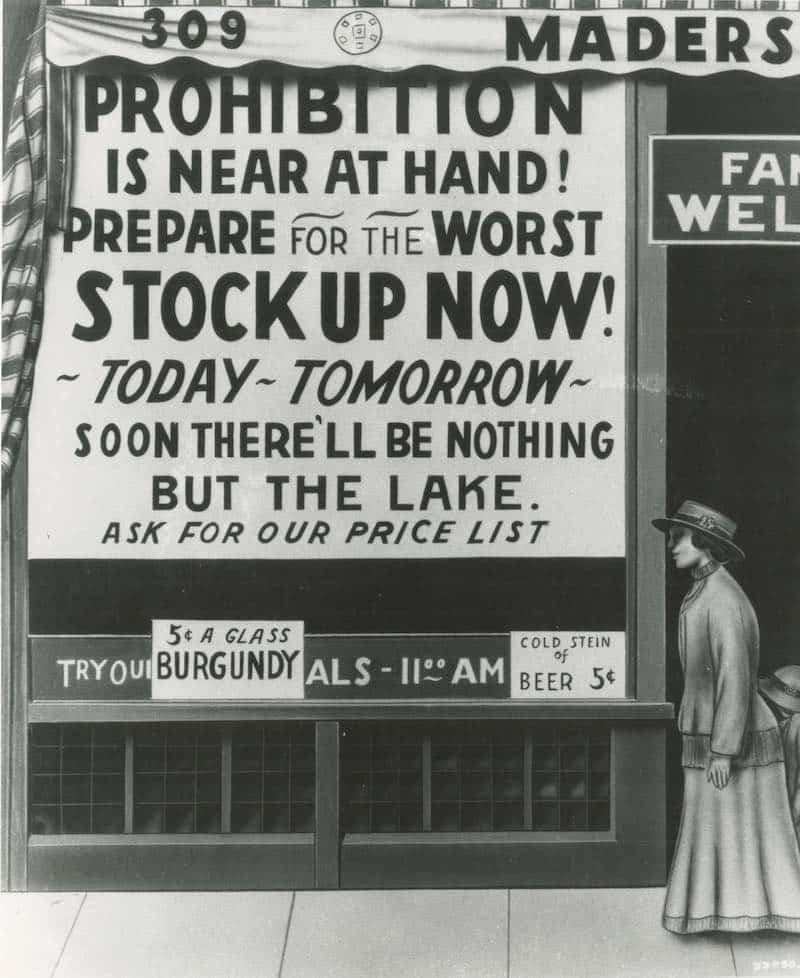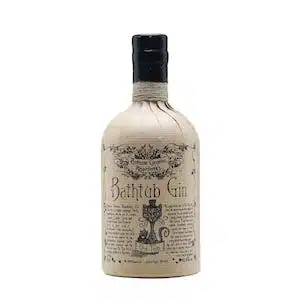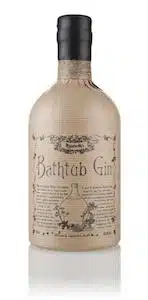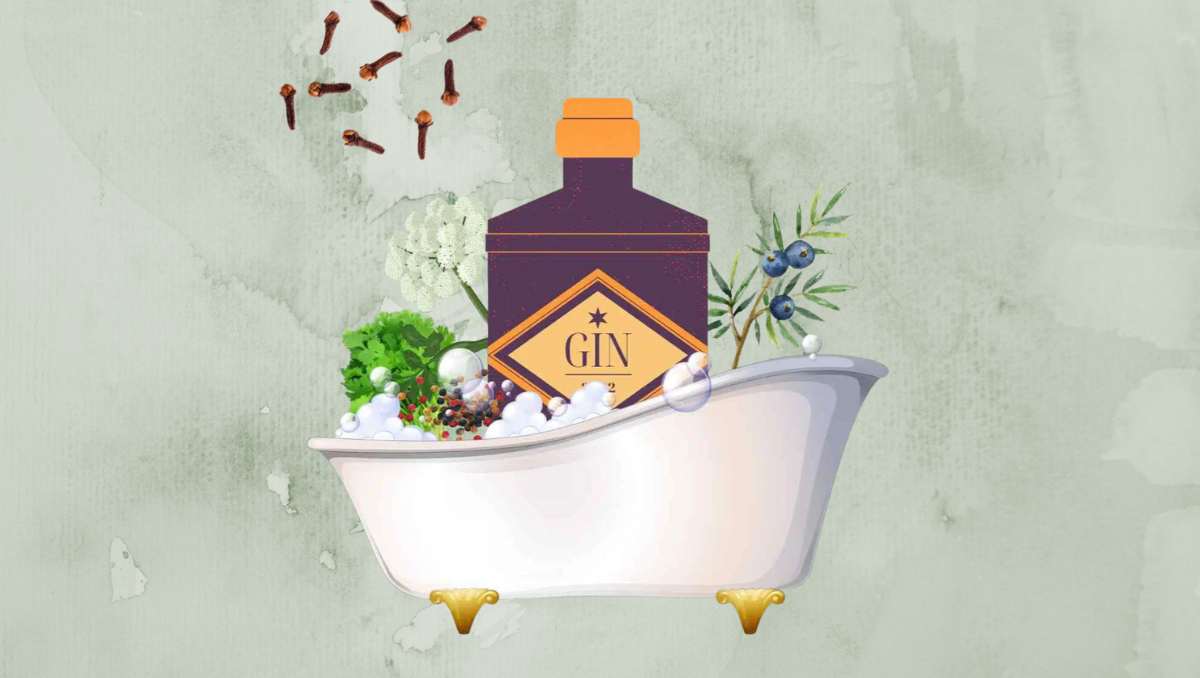You've probably heard of the term “Bathtub Gin” before. But like many others, you might wonder where the term originates from. In fact, the phrase Bathtub Gin was born during prohibition. As people couldn't buy alcohol in a store, they started making it themselves.
Traditional gin is flavored with juniper berries and other botanicals via infusions during the distillation process. Bathtub Gin, on the other hand, is made by macerating botanicals in a neutral spirit, after distillation.
The catchy name has to do with the history of this type of gin and the conditions under which people created the original Bathtub Gins.
Why is it called Bathtub Gin?
It's called Bathtub Gin because people had to infuse or store their base spirit with botanicals in large vessels like bathtubs.

To produce Bathtub Gin in a sellable quantity, people needed a large amount of neutral alcohol and then macerated botanicals or added essences and extracts.
A bathtub had an ideal size to produce a larger amount of macerated gin at once, hence the name “Bathtub Gin."
At this time, the typical materials of bathtubs were either ceramic or metal. Both of them were ideal for the task described above. People used bathtubs or bathtub-like containers to produce comparably large batches of their homemade gin.
In modern days, gin produced using this method is often called compound or cold compounded instead of Bathtub. However, until today, this style is seen as inferior and most popular for DIY gin sets, allowing you to produce your own gin at home.
Bathtub Gin often has a yellowish color due to the maceration of botanicals in it. Infusions happening during traditional distillation will lead to a clear and transparent spirit.
Was it actually made in bathtubs?

Whether the spirit was infused in a bathtub or not, bathtubs were involved at one point. There's no way that people produced the actual base spirit in bathtubs, however, it's likely that they used bathtubs to infuse a spirit with juniper berries and other fragrant botanicals.
The reason I say “probably” is that there's no proof this really happened. We only know that there was black-market gin and the term Bathtub Gin coming up during prohibition in the Roaring Twenties.
If the tub wasn't used by moonshiners as a vessel for macerating or infusing with botanicals, it sure was used as a way to store larger amounts of spirit. This way, they could store their moonshine until they were ready to bottle the liquor.
Bathtub Gin vs. Other Gin Types
The difference between Bathtub Gin and Gin is that for making Bathtub Gin, you add the botanicals to an already distilled spirit. For traditional gin, the infusion of botanicals happens during distillation.
Gin producers add botanicals before or during distillation - as is legally required for all types of gin except for Bathtub. Sometimes, in addition to the infusion during distillation, they will add ingredients, extracts, and essences after distillation. -If legal regulations for the gin type allow such practices.
The thing with Bathtub Gin is that you make it exclusively by adding botanicals AFTER distillation to a cheap. Producers add them to a cheap grain of alcohol and let them infuse for a while.
Thus, infusing a gin with at least one botanical during distillation (e.g., juniper) makes it a distilled gin, not a compound or bathtub gin.
Bathtub Gin, Compound Gin, and Cold Compounded Gin
Original Bathtub Gin, compound, and cold compounded gin all mean the same: A gin flavored with botanicals macerated in a neutral grain spirit or by adding essences and extracts.
Generally, Bathtub Gin is inferior to distilled gins in taste and quality. The catchy name, though, has to do with the history of this type of gin and the conditions under which the first Bathtub Gins were made.
History

The term Bathtub Gin is tightly linked to the prohibition era and first came up in the US in the 1920s as a synonym for gin of poor quality made under amateur conditions.
During prohibition, many people tried to supply others with homemade liquor. People had no access to distilleries and had to produce their alcohol or moonshine at home secretly.
One common way to get base alcohol was to use denatured alcohol (ethanol with poisonous and bad-tasting additives) and then de-denaturing it. This step would remove the dangerous chemicals, leaving you with ethanol. Another way was using small stills to distill moonshine from a mash or wine made of corn, sugar, fruits, or beet.
Consequently, these often were of inferior quality, and one had to mask their harsh bite and unpleasant flavors.
- A pretty famous cocktail was invented due to this: The Bee's Knees. The honey syrup replacing the simple syrup in the classic template of a sour cocktail helped cover up the low quality of the base spirit.
You can read more about this in Tom Sandham's book " World's Best Cocktails: 500 Signature Drinks from the World's Best Bars and Bartenders" (p. 72).
It's also worth mentioning that these homemade gin creations were often not only of questionable taste but even posed a health risk. Poorly produced alcohol contains toxins, which can cause all sorts of unwanted side effects and consequences ranging from severe headaches to losing eyesight to death.
Is Bathtub Gin good?
In general, Bathtub Gin is considered inferior to other gin types. That doesn't mean all brands or bottles of Bathtub or Compound Gin are bad, but the overall quality of this gin style is not as good.
An easy way to avoid cheaply produced Gins is by looking at the label. If it says something like Distilled Gin, Dry Gin, or London Dry Gin, it cannot be a Compound Gin.
Most brands producing compound gin do not hide their production method. So by looking at the label, you will find the desired information 99% of the time. Also, because not all Bathtub Gin is of low quality, a few brands aim to give this type a better image:
Best Bathtub Gins
Even though the average Bathtub Gins is considered low quality, there are exceptions where producers really make an effort. Here are some of the best Bathtub Gins you should give a try:
1. Bathtub Gin Pedro Ximénez Cask Aged Gin

Currently, that is my favorite Bathtub Gin to drink neat. It's also much more than an ordinary compound gin. The producers, That Boutique-y Gin Company, age their cold compounded gin in ex-Sherry casks to create a richer taste.
Tasting notes
The Sherry cask adds a nice little touch to the flavor profile, full of distinctive notes like toffee, cinnamon, ginger, and raisins. That is not uncommon in spirits in general, but certainly unexpected in a Bathtub Gin.
2. Professor Cornelius Ampleforth’s Bathtub Old Tom Gin

This take on a compound combines Old Tom Gin and Bathtub Gin. Both are scarcely regulated gin types, thus, it's surprising that this gin is so good.
Tasting notes
It tastes relatively sweet, as you would expect from an Old Tom Gin, but with an overall traditional flavor profile. Juniper, lemon, and cardamom dominate the nose and palate.
3. Ableforths Bathtub Gin

This product is wrapped in brown paper and solely named after the category. The spirit is produced by Ableforth Spirits, who did a beautiful job with this compound gin.
Tasting notes
The ingredients and flavors come together nicely, and if it wouldn't state so prominently that this is a Bathtub Gin, you probably would not notice.
The nose has delicate aromas of orange blossom, cardamom, cinnamon, and bold juniper notes.
The flavor profile is again rather traditional, with classic botanicals like juniper, cardamom, coriander, fresh orange peel, and cloves.
Modern Day Importance
Even though this style of Gin is still considered cheap or inferior, brands and bars started to romanticize Bathtub Gin, creating new products of solid quality like Ableforths Bathtub Gin. In Los Angeles and NYC, there are even bars named after prohibition-era-born gin.
The New York City outlet is located at 132 9th Ave, Bathtub Gin La resides on Melrose Avenue. Naturally, both bars are speakeasy-style bars with a 1920s vibe. That means plenty of dark wood, vintage furniture, and leather seating areas.

